When an enterprise fails, opinions abound as to why. Some fault the functional structure. Everyone operated in silos. The sales department was the problem — or engineering — or product. Others might find fault with competitors. That competitor raised more money, or locked up a critical channel partner, or chased price towards zero to win market share. Or the problem was the customer. The market was shrinking. The customer’s need for our product went away. Integration with the customer’s legacy technology was too difficult.
But functions, competitors and customers don’t cause failure. Companies fail because their systems fail.
Systems can be fit or flabby, resilient or brittle, self-organizing or controlled from the top. Healthy systems don’t just happen. Healthy systems are healthy because CEOs and leadership teams have made them that way. They have mobilized and coordinated available resources so as to accelerate progress towards the enterprise’s generative and adaptive imperatives, while operating within the constraints of stage and unit economics.
But how?
The secret to high performing leadership is systems thinking. Systems thinking uplifts the leader’s mindset, leading to better decisions. If you adopt a systems view, you will see more clearly the integrated nature of things. You will make more holistic decisions. You will think differently about the role of management. You will think more about language and how to achieve shared meaning. As you mobilize change efforts you will seek to adopt a language that facilitates communication between those in your company with technical backgrounds (such as architects, data scientists, engineers and product managers) and those with business backgrounds (such as operations leaders, marketers, sales leaders and accountants). These insights will improve your decisions, which will increase revenue and profitability. You will be operating from a new paradigm for leadership in a world of digital change: you’ll be “In the Loop.” With time and effort, step by step, you will move your company towards becoming a fit systems enterprise.
If you’re reading this book, you lead an enterprise. You may be the CEO. Or you are a top executive. Or perhaps you are a rising leader in your company, and aspire to executive leadership. Before we dive into the details of the systems view, let’s begin with the basic challenge every enterprise leader faces, every single day. An enterprise leader must maneuver within two constraints to pursue two imperatives. That’s it. That’s the essence of every executive’s job. This is true from early startup to public company. Your effectiveness will be judged by your progress, given these constraints.
The first constraint is stage. Your company’s stage places a natural limit on its maturity. The five-person startup that has just released its first product has higher resource constraints and lower system maturity than a 10,000-person company. The options available to the first in improving its systems are different than the second. For large companies, some choose to stay private and others go public. In general, a private company has more freedom of movement than a public company.
The second constraint is customer lifetime value (LTV). The LTV of your average customer sets a boundary that shapes a company’s design — unless you can change the LTV itself. The commonly accepted boundary condition is expressed by the unit economics formula LTV / CAC >=3. In other words, an investment-worthy company cannot spend more than ⅓ of customer lifetime value (as measured by cumulative gross margin) on customer acquisition. This ratio acts as a balancing feedback loop on growth.
LTV is a fundamental boundary condition in system design. In companies with multiple products, the LTV calculation must be conducted for each. In my first book, Scaling the Revenue Engine, I shared an LTV continuum comprised of five buckets:
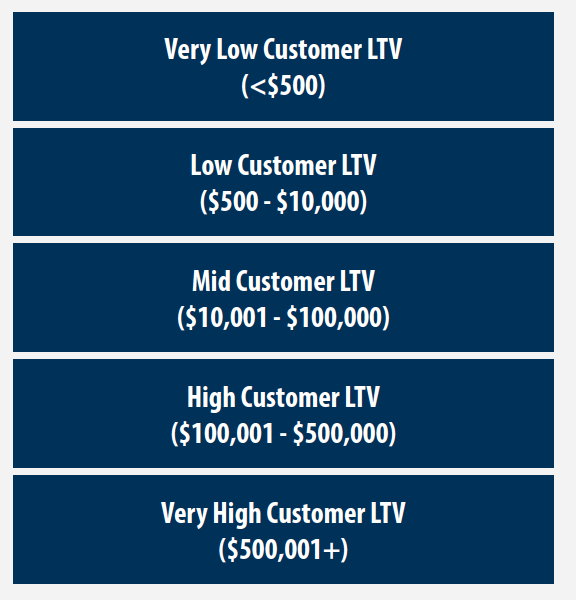
Digital media companies are happy if they can boast $0.09 consumer LTV. Their advertising-based business models require a high volume of consumers to generate meaningful revenue. With a $0.09 LTV, a media company would have the capacity to spend up to $0.03 to acquire a new consumer. On the other end of the spectrum, a B2B enterprise company might feature customer LTV over $1 million. Boeing might boast a customer LTV of $1 billion. Such companies can spend a lot more than $0.03 to acquire a new customer. A company’s customer LTV profile is a big factor in enterprise design.
Working within the two constraints (company stage and LTV), the enterprise pursues two imperatives: to be generative, and to be adaptive. The enterprise’s customer-defined value is always in decline. Value has a half life: customer needs change, and competitors rise. So the successful enterprise must regularly exercise its generative muscle to create new value. That’s the generative imperative. Then, to scale and achieve profitability, the enterprise must also be adaptive. Scalability, efficiency and resilience emerges from a series of breakthroughs and optimizations in culture, workflows and technology.
Successful enterprises maneuver within the two constraints of stage and LTV to maximize progress towards their generative and adaptive imperatives. This is the essential mission of every enterprise.
Now that your mind is wrapped around the constraints and imperatives, you’re ready to ponder how systems thinking will help you better deal with the former and pursue the latter. You are ready to learn the key concepts in systems thinking. This chapter will define what a system is, how to map one, how to map it at the right level of abstraction and how to conceive of the enterprise as a set of systems organized into a hierarchy.
What is a system?
A system is a set of components that interconnect in a structure built to advance a purpose. Purpose governs structure, and structure governs behavior. In a business, systems are socio-technical. In other words, business systems are comprised of people pursuing a purpose by interacting with technology to advance workflows.
How you describe a system — the contours of its boundaries and the definition of its elements, interconnections and structure — is a model. A system model is created by you to better understand reality. A model is never reality itself — it is simply your best facsimile of reality, given the problem you seek to solve. The quality of that model depends on the degree to which you, the modeler, understand system purpose, structure, behavior and performance.
Every system has its boundary. A boundary has integrity when a preponderance of work occurs inside its edges, pursuing a unique purpose. While every system worth the title has internal integrity, systems pass information back and forth with adjacent systems.
The basic building blocks of a system are quite simple. Any system is an interconnected web of stocks and flows.

A stock is an element you can count, or measure, or feel. It is the amount of cash you have in the bank. It is the amount of energy you have at the end of the day. It is the brand equity you have in the market. It is your compute capacity.
Flows can either be the inputs that come into a stock, or the outputs that flow from it. They are physical activities — where the work gets done. Transformations occur inside of flows. For instance, revenue generation flows and VC fundraising flows are inputs that increase the stock of cash. Accounts payable and payroll are output flows that decrease the stock of cash. In manufacturing, work in process is an input flow that increases the stock of inventory. Sales and shipping are output flows that decrease the stock of inventory.
Feedback loops are information streams. They act on flows like control knobs. Feedback loops emerge from stocks. As they interact with flows, they influence inputs and outputs, which in turn influence the status level of stocks (and their trends over time). Like this (feedback loop in green):

Feedback loops influence behavior, creating cause-and-effect cycles in systems. As such, they are the source of dynamic complexity. Causes and effects can be intended and unintended; obvious and non-obvious. The time gap from cause to effect may be stated in nanoseconds or years. The In The Loop leader works hard to detect these dynamics when they are relevant to business performance.
Feedback loops are critical components in systems — especially in the fit systems enterprise. In The Loop leaders understand that.
Consider the revenue engine system. Let’s say yours is a B2B SaaS company. How does Company A become a customer? Company A has a problem that causes some type of pain. This pain can be considered a stock, because it can rise or fall. The level of pain experienced by Company A will impact the degree of interest in finding a solution to the pain. As Company A searches for solutions, it finds other companies that are competitive to yours and assesses how well these companies can solve Company A’s pain. This is competitor brand equity. In this process, Company A also assesses you — your brand equity.

The level of Company A’s pain acts as a feedback loop, impacting the intensity of the search, like this:
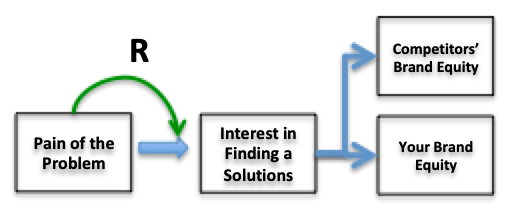
Feedback loops can be either balancing or reinforcing control knobs. Because they cause dynamic effects, it is helpful to view them as circles, with the status of stocks acting on flows. This is a reinforcing feedback loop. The higher the pain, the more intensive the search. That causes the faucet to open, like this:

Consider a balancing feedback loop. If cash is running low in a tech startup company, a controller might slow down accounts payable — holding off on payments to certain lower priority vendors. The faucet closes, like this:
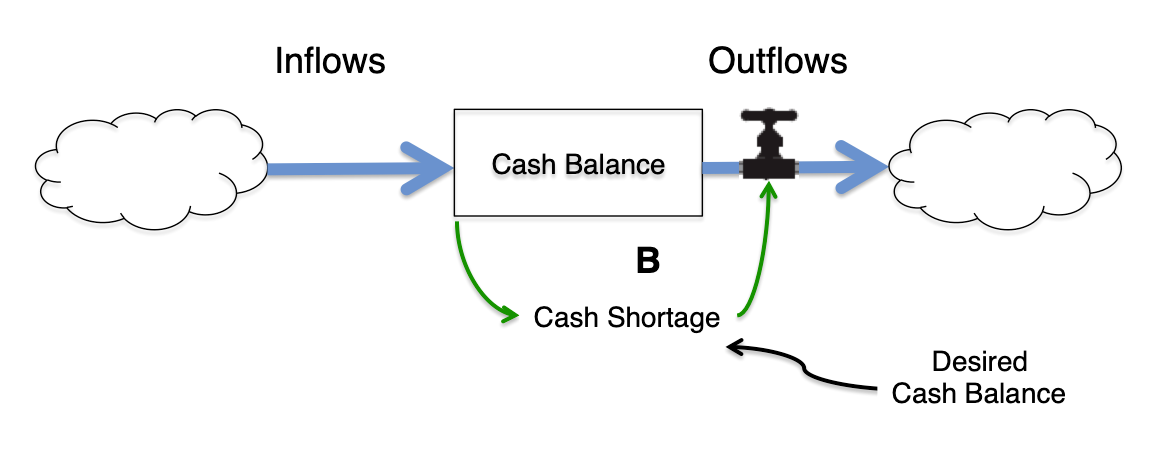
A reinforcing feedback loop shows an escalation pattern. In raising funding for a hot tech startup, an excess of investor demand versus funding round supply can push up the stock called enterprise market value (in funding terms, this is expressed as pre-money valuation). The interest of investor Y causes investor Z to bid above Y’s pre-money valuation, which causes Z to raise her pre-money valuation, and so forth — until a balancing feedback loop (in this case, a rational investment return model) causes one investor to step away. Like this:
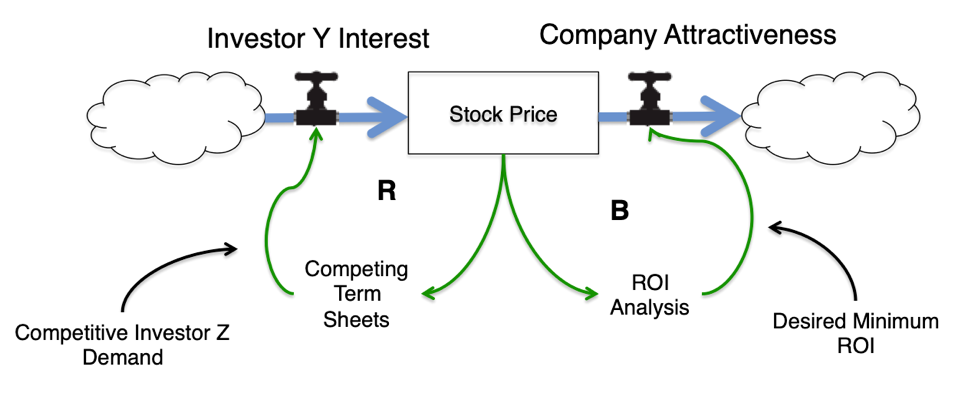
Because of stocks, which act like bathtubs, inflows and outflows can be managed independent from one another. If inflows exceed outflows, stocks rise. If outflows exceed inflows, stocks fall. If inflows and outflows are kept in balance, stocks stay in equilibrium. A feedback loop exists when the status of a stock affects the inflows or the outflows, or both. Such as “the bathtub is too low — I need to turn the faucet on.” Feedback loops enable stocks to be buffers, or a source of momentum, or ballast.
The structure of stocks, flows and feedback loops in a system dictates its behavior. If you understand the dynamics of these stocks, flows and feedback loops, you have come along way towards understanding the system.
To fulfill any system’s purpose, a set of transformations must occur. When drawing a system map, start with the essential transformation you seek. Transformations happen in flows, resulting in changes in stocks. You can then build the remaining system components around it.
For instance, the revenue engine system map’s design is tied to its purpose — to efficiently move prospects along the customer journey towards a sale, and then to retain the customer and expand customer spend. In the revenue engine system, the necessary transformations are in the mindset of a target customer. Let’s go back to the case of Company A noted earlier — where the company is experiencing pain in a business process, and needs to find a solution. Let’s imagine that yours is a B2B SaaS company selling a mid to high lifetime value (LTV) product. Continuing pain experienced by your target customer causes a reinforcing loop to act upon the interest in finding a solution. This in turn affects the intensity of the search. As Company A considers your company’s product, your company’s stock of brand equity changes — up or down.
Of course, the customer is not simply a researcher, gathering static information from your company and competitors until a decision is made. You are also an actor in this system. Your brand equity may start off well established (high), or it may be low. It changes in response to acts of engagement and their associated messaging. As I described in my first book Scaling the Revenue Engine, prospects “lock in” on a new mindset about your product in three stages (which are stocks). The flows coming out of them “pour into” brand equity. Two of these stocks occur before purchase and one after purchase.The three stages (stocks) are vision lock (“I get what you do and why it’s relevant to me now”), conviction lock (“I’m convinced. Sign me up”), and advocacy lock (“I’m a raving fan”).
Let’s map the customer’s perspective:

You will notice that vision lock, conviction lock and advocacy lock flow into your brand equity, but competitors’ brand equity flows out of it. In other words, prospects compare you to competitors in ascertaining your brand equity. Notice the feedback loops. If pain is intense, that creates a reinforcing feedback loop on the flow of finding solutions.The degree of competitor advantage or disadvantage comprises a balancing feedback loop on the flows between the three locks and your brand equity, while rising levels of the three “locks” comprise a reinforcing loop. Events that increase the stock of vision lock, conviction lock and advocacy lock create a reinforcing feedback loop on the flows that pour into your brand equity. All of these feedback loops could be shown more completely as circles, with causes and effects made more explicit, to communicate their dynamic nature.
Quality messaging comes from a clear, true, segment-specific brand identity (which is a stock). Messages are sent through campaigns. Campaigns are high quality when channels of distribution are prospect-relevant, and when touch points exhibit volume and diversity. Clear, true brand identity and high quality campaigns don’t just happen. They depend on the competency, motivation, energy and staffing levels of your marketing team. This team is responsible for a domain: the campaigns domain.
Systems are made up of domains. The choice you make as to the boundary contours of a domain is a very important decision. For each domain, you need to define the business outcomes you seek — now, near and far. These need to be clear to the team assigned to that domain.
In this case, the actions of the campaigns domain team interact with the customer’s search for solutions like this (for simplicity, without the feedback loops):

If we include the human engagement steps taken by Sales Development Reps, Account Executives and Customer Success Managers, it looks like this:
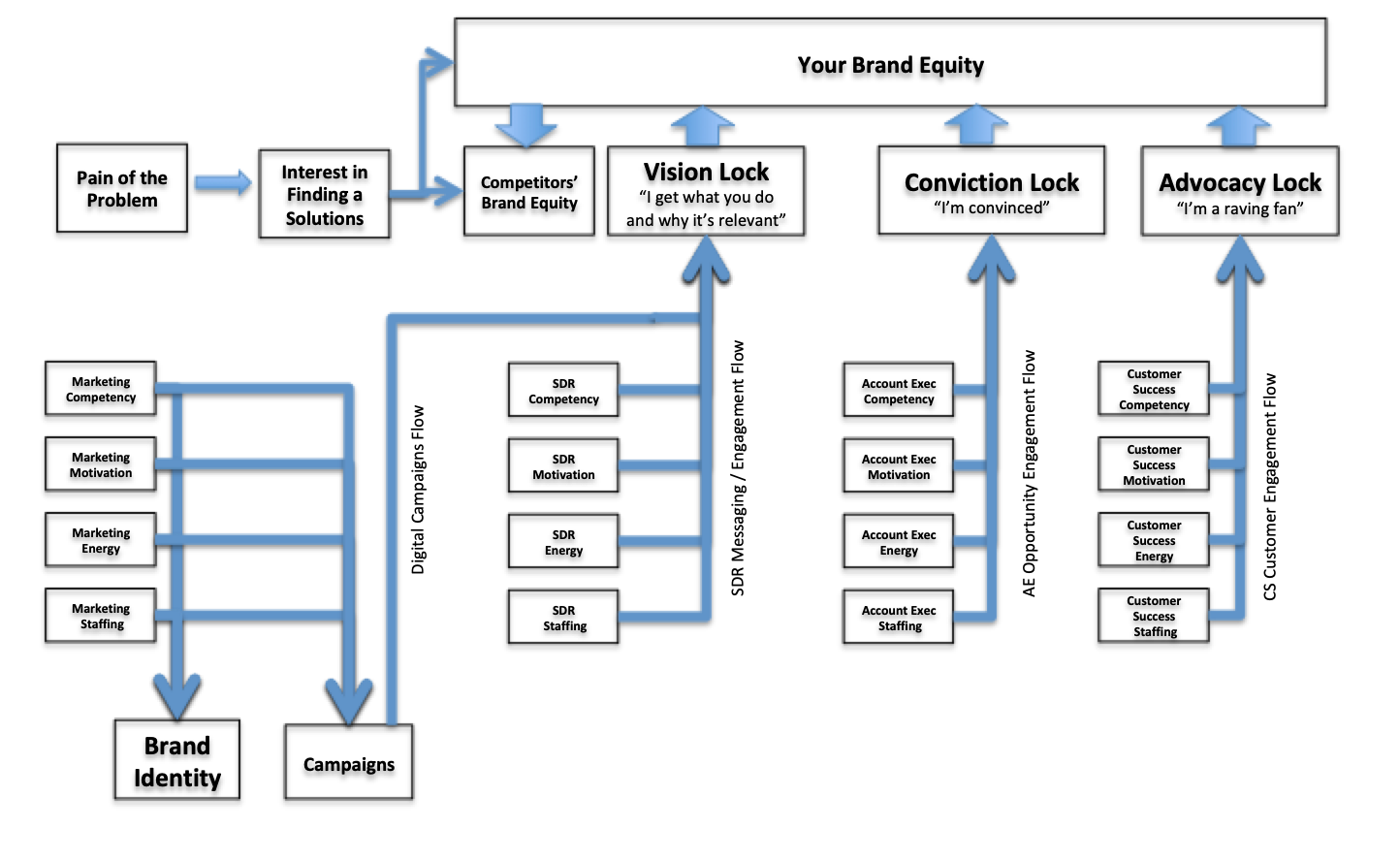
You will notice that competency, motivation, energy and staffing are the four key stocks associated with all of these roles. As you might have guessed, the same is true for every role in the enterprise.
Let’s keep building out our map. If we go further and add a launch team, along with the underlying workflows and data states, it looks like this:

But we aren’t done. As mentioned earlier, enterprise systems are socio-technical. Technology supports workflows as shown below:
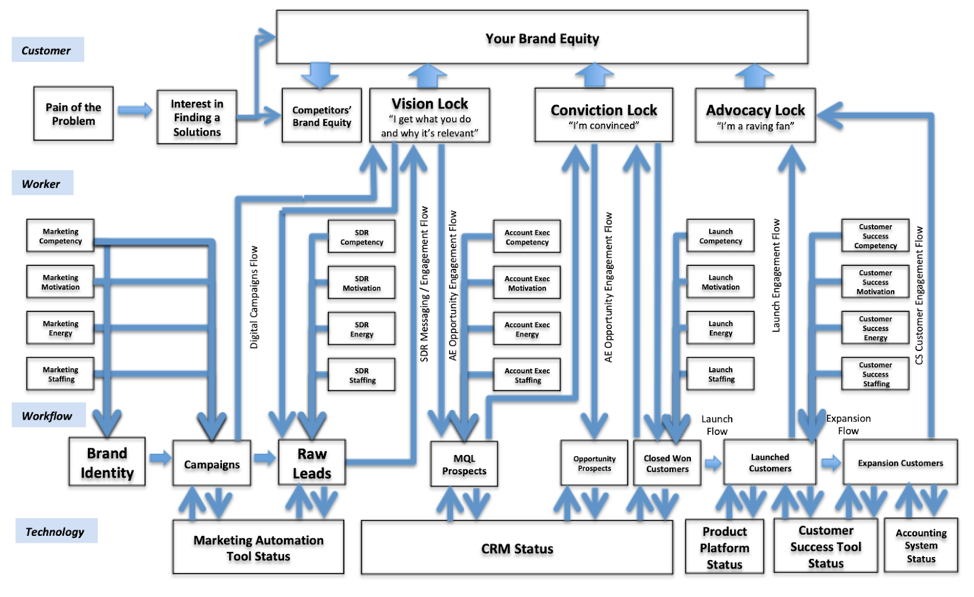
We’re getting closer, but there is one more step. An enterprise system can’t run without money. Here is the revenue engine system map, including money flows:
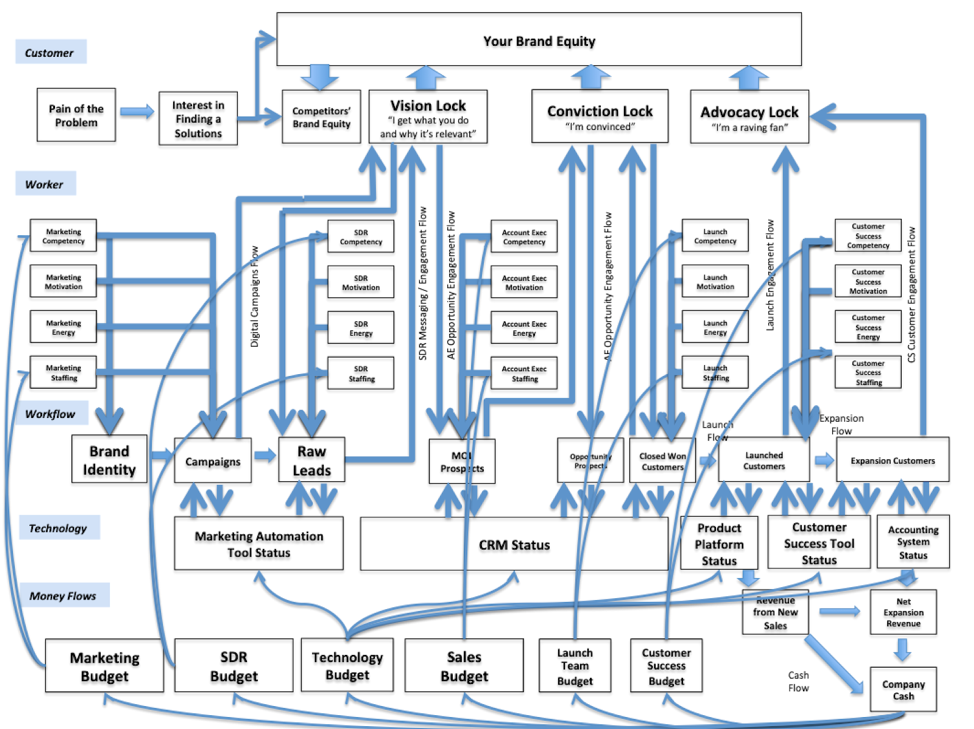
A system map such as this is a snapshot — a static representation of the interrelationship between components in the system. A feedback loop is dynamic — it shows the behavior of flows and stocks in a system over time. When a review of stocks and flows in your system of interest reveals problems or opportunities, you can then draw feedback loops so as to better understand the cause-effect behaviors. More about this in Chapter 8 (Dealing With Archetypes).
Any system is comprised of domains. The level of granularity of domain definition will depend on a number of factors, including the stage of your company. For every domain, there should be at least one team assigned to it. In this revenue engine, we could conceive of ten domain teams as follows:

Standing teams can be of two types: operational or technical. Technical domain teams seek to bring digital leverage to the domain. Operational domain teams seek to optimize execution of any required human steps within the domain. One domain can feature both team types, as with the the onboarding domain, above.
Some teams are episodic — meaning they are spun up to complete a project or some short-term assignment. For instance, in the accounting system, auditing is a domain. The external audit team is an episodic team.
For each domain, you need to determine the business outcomes you seek — now, near and far. Then you challenge domain teams to do what it takes to achieve these business outcomes. When modeling a domain, technical teams will break the domain down further — into subdomains. These subdomains may exist at the data layer, the application layer, the integration layer or the infrastructure layer. Domain driven design enables teams to architect and build software based on reactive microservices principles.
Why take the time to create such a complicated map? Isn’t it overcomplicating things? No.
Enterprise systems are inherently complex. They are comprised of an intricate web of interactions between people, workflows, technology and money flows. When you want to navigate a city, you get out a map. A city map’s confusing mix of buildings, parks, streets, highways and cul-de-sacs may be complex, but it’s the reality you need to understand to get around. The same is true with an enterprise system map.
Once you have drawn a system map, it becomes a model of reality executives and teams can use to isolate and describe problems. The visual flow will help leaders more quickly identify and describe non-obvious connections — such as the effect of broken workflows on employee motivation. The model itself will continuously evolve, as changes to workflows are made and as teams think more deeply about the integrated nature of things. But its existence (on a work area wall, or on a PowerPoint slide) will help leaders focus conversations, deepen understanding and create alignment.
As you can see, the flow of money is an important part of the revenue engine system. In fact, the performance of the revenue engine system impacts the amount of money available to invest in it, and the available money impacts the quality of the revenue engine system. The relationship is symbiotic. You will notice that money can buy competency and staffing, but it can’t buy motivation and energy. An effective revenue engine spends money to make a lot more money, achieving specified unit economics thresholds (such as the lifetime value of a customer should be at least three times the customer acquisition cost). If unit economics are not achieving the minimum threshold of LTV / CAC >= 3, the map can help leaders and teams identify potential problems.
The cash management system, like the revenue engine, spends money to make more money. It spends money to pursue investors — who hopefully respond by investing much larger amounts of money into the business. All other systems in the enterprise are cost centers; the goal is to achieve system purpose with the minimum possible expenditure of cash.
We noted earlier that when creating a system map, you should start with the essential transformation at the core of the system’s purpose. For some business systems, the necessary transformation is in a stakeholder external to the company. This is true with the product discovery system (the desired transformation here is the customer’s discovery of value), the cash management system (the investor’s readiness to invest), and the revenue engine system (the customer’s readiness to buy and expand). For these systems you begin with external stakeholder transformations. For these system maps, everything else on the map is in service of these transformations. In other systems in the enterprise, such as the accounting system, the necessary transformation is, to a large extent, internal (in the accounting system, transformations include turning accounts receivable into cash inflows, turning accounts payable into cash outflows, and properly accounting for and reporting on all money flows in the business). Whenever you map a system driven by an internal transformation, start with the workflow steps; the rest (people, technology and money flows) follow.
The map example we chose in this chapter was of a revenue engine system, but we could have chosen the product management system, the accounting system, or any other operating system. The specifics are different, but the building blocks are the same. Other system maps will show up in Chapters 13 and 14.
System maps are worth the effort. They help you see the integrated nature of things and the help you to diagnose system health. The very act of drawing the map causes you to ponder how things are organized — and whether that method of organization makes sense. By thinking through how feedback loops interact with stocks and flows, you are compelled to consider the variety of factors influencing system performance. By defining the stocks that matter most across people, workflows, technology and money flows, you have begun to define what to measure on your metrics dashboard.
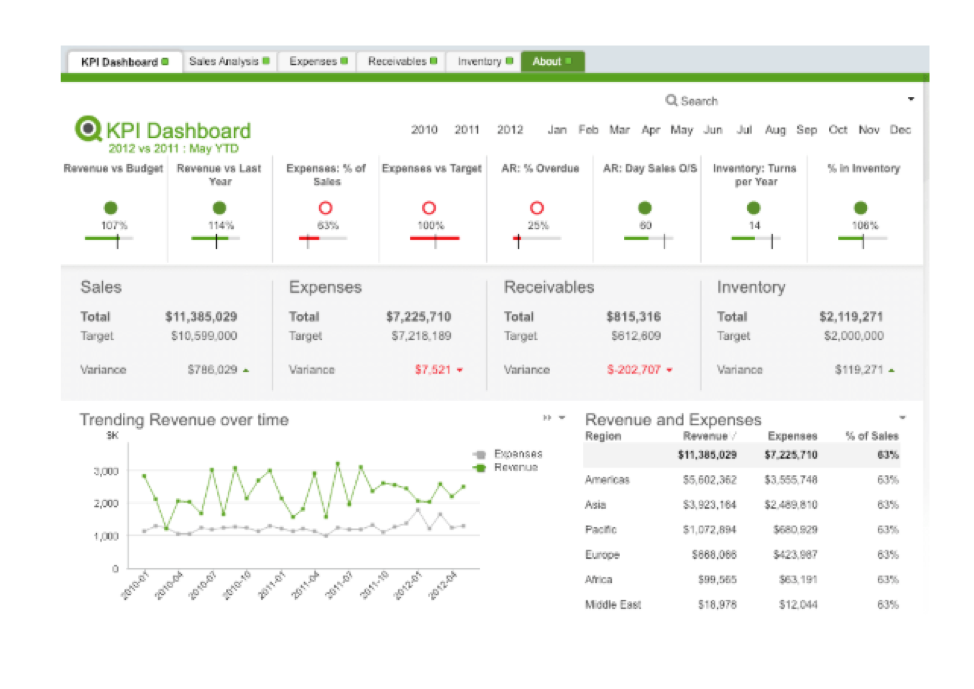
System maps contribute to systems thinking.
The Enterprise Hierarchy
From the vantage point of many CEOs and senior executives, the enterprise is viewed functionally, like this:
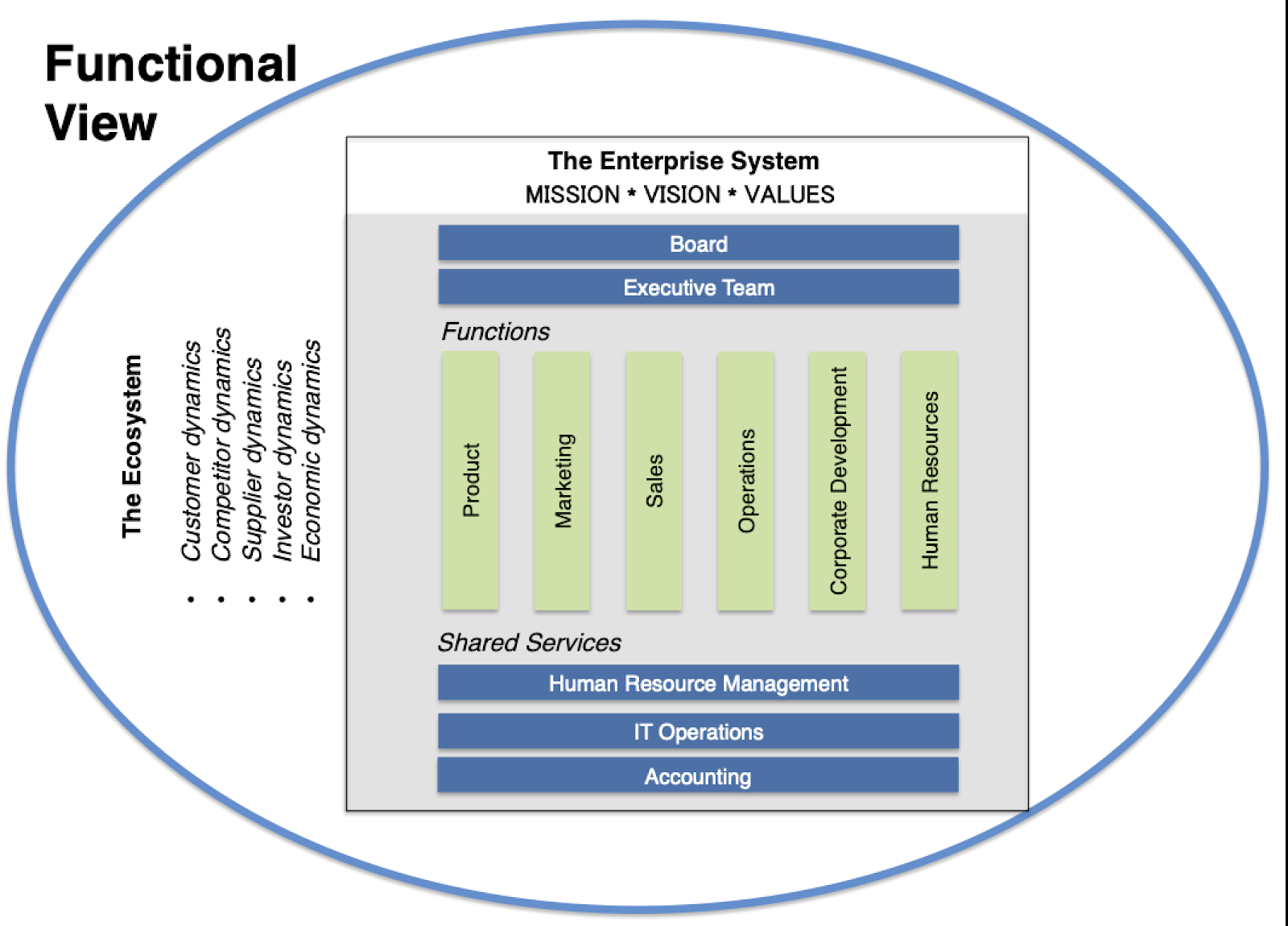
There is the board, the exec team, all of the line departments and some staff departments that provide shared services. These operate in a functional hierarchy.
But this structural-functional view is insufficient for today’s leadership context. Operating from a structural-functional paradigm, a leader can underestimate the integrated nature of things. This is risky in a world of accelerating digital change. When In the Loop, a leader thinks differently about the enterprise. The enterprise is comprised of multiple systems. These systems operate in naturalhierarchies.
The highest level of the hierarchy is the ecosystem. The ecosystem decides (based on target customer needs and market dynamics) whether your enterprise has won the right to survive and thrive. Inside the ecosystem is your enterprise, which is itself a system. Like nested dolls, the enterprise system is governed by a virtuous vision, a clear mission and cultural values; then meta systems; then operating systems.
It looks like this:
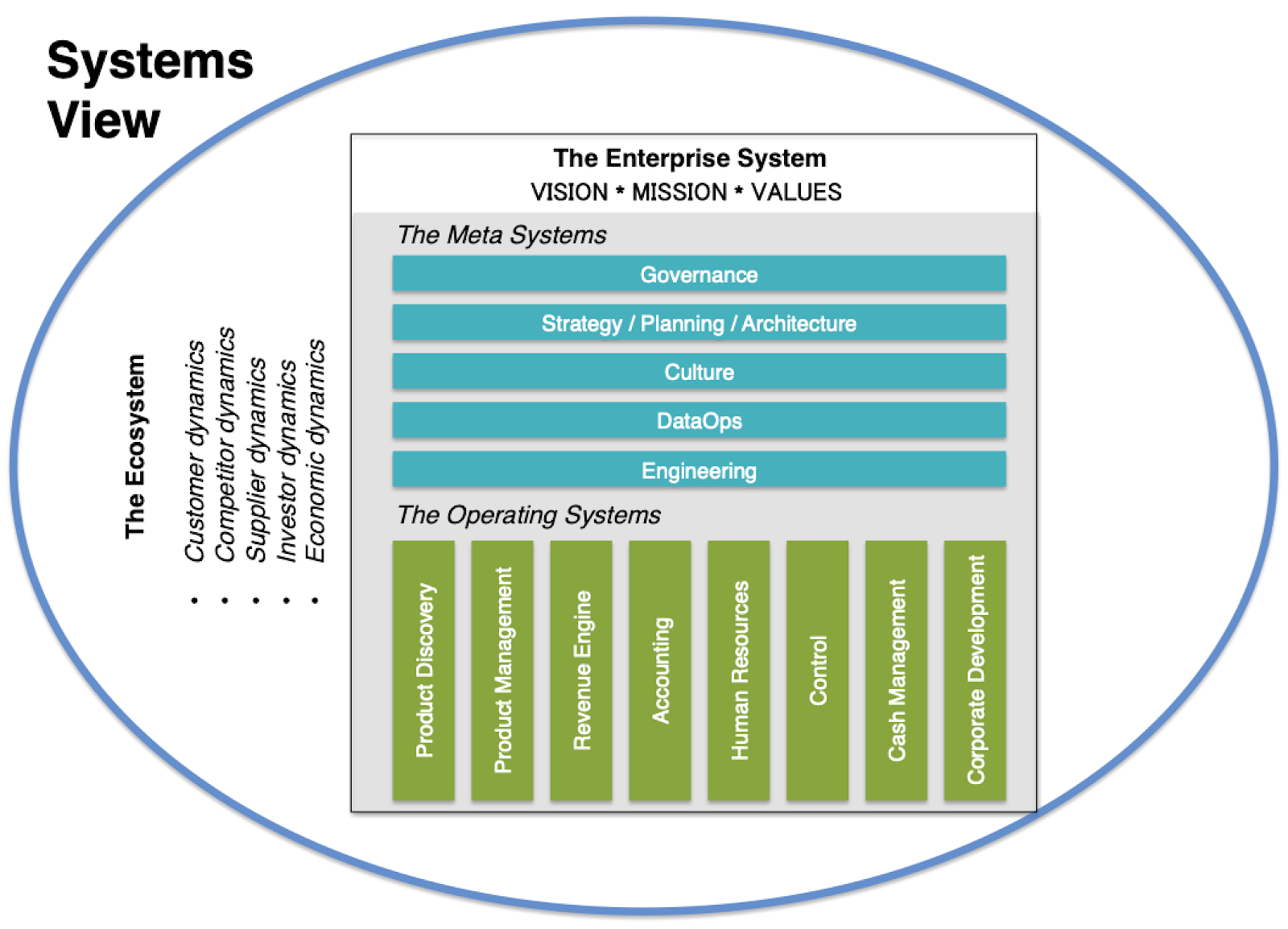
Day to day operations of the business occur inside the operating systems. The product discovery system discovers new customer-perceived product value. The product management system improves existing customer value by enhancing existing products. They are different. The accounting system manages the flow of money into, out of and through the company. The cash management system ensures there is sufficient cash in the business, through funding efforts and cash conservation. The human resources system manages the talent lifecycle. The revenue engine drives profitable growth in customer acquisition, retention and expansion. The control system manages the legal, compliance, security and privacy risks of the business, often leveraging insurance to mitigate these risks. And the corporate development system pursues opportunities for M&A. If your company has significant physical operations, then a physical operations system exists as well.
Above the operating systems are the meta systems. The only purpose of a meta system is to supply leverage to the operating systems. If a meta system does not provide leverage to operating systems, it is worse than irrelevant — it is an obstacle to growth. The meta systems include the governance system, the strategy/ planning / architecture system, the culture system, the DataOps system and the engineering system. The governance system directly interacts with one meta system (strategy / planning / architecture) and three operating systems — the accounting, cash management and control systems (and indirectly with all others). The strategy / planning /architecture system interacts with all operating and meta systems. The culture system does too, though it is especially connected to the HR system. As a meta system, the culture system is focused on nurturing the aspirational culture of the enterprise; the human resource system is an operating system focused on managing the talent lifecycle. The engineering system interacts with every operating system that maintains enterprise-built technology. The DataOps system interacts with all operating systems.
All systems (both operating and meta) are comprised of domains. Domains are managed by domain teams. Operating systems may feature domain teams of three different types — operational, technical or episodic. For instance, an operating domain team conducting human work might be paired with a technical domain team (a development team) that is working to automate some of the human activity.
The five systems designated “meta systems” exist to deliver meta-resilience to all operating systems. A system provides meta-resilience when it improves the feedback loops inside other systems. When the five meta systems perform effectively, operating systems are more capable of self-organizing and self-healing in pursuit of their purposes.
Consider how the meta systems impact the revenue engine system. The governance system (led by the board) reviews the revenue engine system’s performance and, based on that assessment, advises the CEO on strategy. The strategy / planning / architecture system (led by the CEO and executive team) governs and sets the enterprise’s strategic goals and plans, including the goals and plans of the revenue engine system. It also clarifies its purpose and priorities, and designs its basic architecture (organizational, informational, executional, communications and technical architecture). The culture system supports revenue engine participants in maintaining alignment with company culture. The engineering system delivers leverage to the revenue engine system through the architectural frameworks and development methods that ensure fit technical systems and better performing digital products. The DataOps system ensures clean data infrastructure and a data driven culture, so that the revenue engine system can rely on one source of truth and has access to the data it needs to continuously improve.
Operating systems also are impacted by their adjacencies. For instance the product discovery, product management, accounting and corporate development systems exert influence on the revenue engine system. In fact, interdependence is a feature of all company systems. While each system fulfills a unique purpose and conducts most of its operations within its own boundaries, it also passes messages and work back and forth between adjacent systems.
For most, conceiving of a company as a set of systems is, at first, foreign. And yet, if you want to fully appreciate the enterprise and ecosystem dynamics that will impact your company’s capacity to scale, systems thinking is critical. We mentioned earlier that every socio-technical system in an enterprise is comprised of people, workflows, technology and money flows. An In The Loop leader will map these relationships so as to uncover the system’s integrated nature and dynamic reality.
Workers are central to the health and performance of enterprise systems. For any given role, worker effectiveness is impacted by the status of four stocks: competency, motivation, energy and staffing. If a human step in the workflow is managed by competent, motivated, energized people in sufficient numbers given demand on that step, then the step will be performed effectively.
In the fit systems enterprise, workflows are designed such that high quality work can be executed efficiently, especially at cross-functional handoff points. Technology can provide workers and workflows great leverage when effectively selected, built and deployed. Whether it be the automation of tasks, the simplification of the user experience or the leveraging of data for analytical insights, technology done well increases the quality and efficiency of your systems.
Money flows throughout systems — specifically into labor, non-labor marketing investment and technology. Money is invested in a workflow to maintain or increase system performance per unit, volume or velocity (or all three). Rational investments of money are made with the purpose of driving an attractive ROI — at least in the long term.
Abstractions
The revenue engine system map shown above is a high-level abstraction. It illustrates the connection between people (both internal and external), workflows, technology and money flows. As you create system maps, you must deal with the abstraction question. How detailed should your map be? The reality is that with any system map it is possible to double click down to a mind-numbing level of detail. But that’s not your purpose. A map is a tool for communication and alignment. Its job is to help with diagnosis and to get everyone on the same page. For the engineer writing code, the architectural abstraction level must be quite low. For a self-organized domain team redesigning its workflows, the abstraction level is higher. For an executive designing strategy, it is higher yet. Draw the map that is most helpful, given the problem you are trying to solve.
No matter what level of abstraction you draw, it is also important to see the abstraction levels above your level of interest. This gives you a direct line of sight from the intervention you are planning, on up to system purpose, on up to enterprise purpose. You need to understand where the problem fits inside the system, and within the enterprise overall. These cascading abstractions provide a means by which non-technical and technical leaders and employees can get on the same page. If you don’t map the cascading abstractions you are more likely to design low-level solutions (like software) that are locally optimal but are misaligned with the overall system or enterprise purpose.
Summary
Every system in your company exists in a current state of health and maturity. As CEO, it’s your job to uplift these systems (consistent with your company’s stage and unit economics profile). If you are In the Loop, you will diagnose the current state of your company and its systems more accurately. You will get to root cause. You will understand the interrelationship between people, workflows, technology and money flows. You will be more likely to design into your systems the capacity for self-organization and self-healing, and to more effectively balance alignment and autonomy in the teams that make up your company’s systems. You will focus more of your energy on the meta systems, ensuring they deliver leverage to the operating systems. You’ll work harder on culture and on finding and developing top talent. As a result, you will more effectively advance the generative and adaptive imperatives of your business, accelerating your enterprise’s growth in revenue, profit and impact.
In poorly run companies, systems are flabby. Flabby systems are easy to detect. Just look for rework. Clogged process bottlenecks. Multiple versions of data “truth”. Symptomatic quick fixes that create downstream disasters. Whack-a-mole management. Dysfunctional business partnerships. Bad products. If you have flabby systems, customer centric marketing campaigns will fall on deaf ears. Healthy culture morale-building campaigns will be resented. Grand promises to investors will be dismissed. The dysfunctional reality of flabby systems will speak louder than your words.
Are your systems fit and trim? Are they self-organizing and purpose driven? Have you leveraged your systems to become both generative and adaptive? Are you able to conceive of your company as a set of systems, and bring systems thinking to their continuous improvement? Like physical fitness, there is no destination. It’s a continuous journey. Progress is hard won. It takes great discipline to be an elite athlete. So too with the fit systems enterprise.
Systems don’t lie. They will exhibit quality and caring, or they won’t. If you are the CEO of a flabby systems enterprise, be warned — your company’s future is at risk. If you are the CEO of a fit systems enterprise, on the other hand, you can expect to survive, thrive and drive towards a future of your own creation. It’s that simple. One road leads to perdition, the other to the promised land.
What’s your choice?
If you would like more CEO insights into scaling your revenue engine and building a high-growth tech company, please visit us at CEOQuest.com, and follow us on LinkedIn, Twitter, and YouTube.

